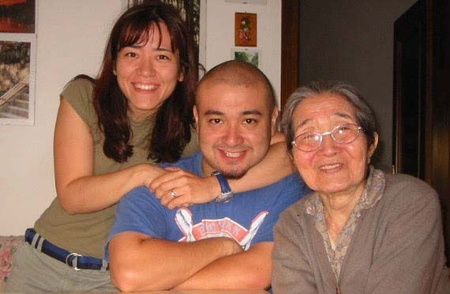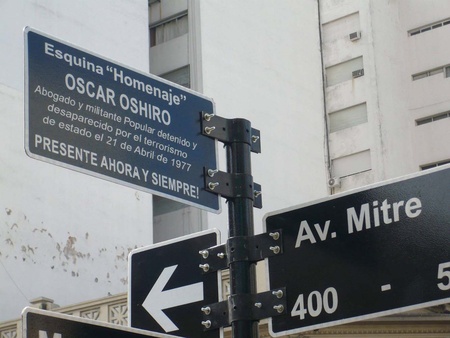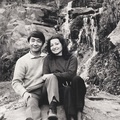My family went through a difficult time. It’s not like you could go to the police and ask for their help in finding my father; they were complicit with state terrorism. I am not sure how my mom did it all, but she managed to find other relatives of desaparecidos. She would leave during the day and come back late at night. My grandmother Teresa and I would keep looking through the window shutters, waiting to hear my mom’s car so we could go downstairs to help open the heavy metal garage door for her.
Those days seemed endless, as I lived with the fear that the dictatorship would take my mom away as well. Many kids were left without both parents. My mom was a tough woman; she wasn’t afraid to speak her mind and she didn’t care who was in front of her. My grandma and I knew this, and so we feared for her life during this time when speaking your mind could get you in big trouble, or worse.
My mom met Mary Higa, whose disappeared brother Juan Carlos Higa had been a literature student in college and a journalist for Akoku Nippo and La Plata Hochi, the two main newspapers of the Japanese-Argentinian community. Juan Carlos was also an accomplished poet. His mother was blind and very sick, but she held on for as long as she could because she was sure that her son was coming back. Unfortunately that never happened.
Beba and Mary would visit other Nikkei families whose relatives had been abducted. Together, they unofficially founded Familiares de Detenidos y Desaparecidos de la Colectividad Japonesa en la Argentina (Relatives of the Detained and Disappeared of the Japanese Community in Argentina), which is still in place today. Jorge’s older sister, Elsa Oshiro, continues the quest for justice and the demand to know what happened to all of our family members.
Many desaparecidos had dual citizenships with other countries. The lucky ones were citizens of countries that acted fast enough to file a habeas corpus petition, forcing the abducted to be released to them, after which they could go into exile.
The Japanese government didn’t want to get involved with the desaparecidos and Argentina’s internal affairs. The Italian government was more willing; they issued an Italian passport in my father’s name so that we could all go to Italy if he was released.
For ten years, my mom looked for my dad in any way possible. One time she got a tip on where he might be from a witness who was released. We drove past Buenos Aires city limits, full of hope thinking that this was the day we had all been longing for. But once again, we went home empty-handed. My mother never lost hope and she always had new ideas for how to find Oscar. For a long time I maintained the same hope. Every time the doorbell rang, I hoped to see my dad’s face, but I always ended up disappointed.
In 1983, Raúl Alfonsín was elected the new president of Argentina. The country was returning to democracy, and my mother and I and all the relatives we met thought that the desaparecidos who were still alive in the detention camps would be released. During Alfonsín’s campaign, he promised voters that there would be no impunity for the crimes committed during the state terrorism years of 1976–83.
In 1986, President Alfonsín signed the controversial Ley de Punto Final (Full Stop Law), which stopped the further prosecution of members of the military and civilians involved in state terrorism. Congress repealed the law in 2003, but my mother didn’t live to see this event. She only saw that justice wasn’t being served and that murderers were walking free among us.
Realizing that my father was not returning, my mother decided to leave the country with me and my brother Leonardo, but a lot of problems emerged. In order to leave, we were required to have a valid passport and my father’s permission, since my brother and I were still underage. Since my father had “disappeared,” he was still considered alive by the law.
My mother was able to get permission from a judge by pretending that we were going to take a vacation and come back. For us it was a permanent vacation; I couldn’t return to Argentina until I was 18 years old.
Moving to Italy was like the dawn of a whole new day for my mom, my brother, and me. We never forgot my dad; he was always there in the back of our minds. My mom never remarried even after she got his death certificate. She told me that he was the love of her life and there was no point in replacing him with someone else since no one could compare to him.
We never talked about my dad anymore. We mourned him in silence. I think she was sorry that she couldn’t save him. Every so often she would say a sentence about my father, a few words with deep meaning. Like when she told one of my friends that my dad was tired of running and upset that he had tried to help people and it was all coming back to haunt him like a curse. The military kept chasing him until they got him.
My mom bought an industrial photo lab in Treviso province in the Veneto region. I was attending a scientific school but I begged my mom to let me choose my own path and she agreed. I took several tests and got into a fine arts school.
That period of my life was like a rebirth. I found my place in the world; I could finally express myself freely without being afraid of who was in front of me. I made friends then that I still call family, even now after twenty years.
When I was in Argentina, we couldn’t tell anyone that my dad was missing. I would lie to strangers, telling them my dad was at work if they asked. With so many informers working for the dictatorship, you couldn’t just say whatever you wanted. We lived with our guard always up, looking over our shoulders to make sure no one was following us.
When I walked on the streets of Treviso, I felt safe. I could be that carefree kid that I should have been in Argentina, with normal problems like studying for tests and getting the sketches for drawing class.
Treviso in the 1980s and ’90s didn’t have a Japanese community or any other Asians. I was the only Nikkei in school and in town, except for the occasional Japanese tourists. My teachers would remember my name the first week of school, which meant I was always singled out, but I didn’t care. I found it funny. My classmates were curious about me, as I was about them. We just clicked. This didn’t happen in scientific school, but in art school, we were all kind of odd in the eyes of other school kids, so I fit right in.
After I finished art school in 1991, my mother decided to send my brother Leo to live with my grandparents in Argentina. She then proceeded to sell the photo lab where I was helping out after school, pack everything up, and move back to Argentina herself. At the time, I couldn’t understand her motives.
She was sick, and she hid it from us until it was almost the end. The first thing she did back in Buenos Aires was to meet with Mary Higa. Then she went back to her old ways, trying to find answers about my dad.
At that time, Italian judges were looking for desaparecidos survivors to serve as witnesses to process members of the military dictatorship. This was something the corrupt government of President Carlos Menem didn’t do, so other countries had to step in to seek justice for their desaparecidos. Menem freed and pardoned all the murderers. That was a kick in the face not only for my mother but for all the families of the disappeared.
On February 28, 1995, my mother, Edvige “Beba” Bresolin Oshiro, passed away in Buenos Aires. She was still thinking about my dad, calling his name.
What happened to my father? How did it happen? What was he thinking about? Where is he buried? These are the questions that continue to linger. Will I ever get any answers? I really hope so, but since I can’t seem to find the answers in the outside world, I took the introspective road.
It all started when I decided to help Nikkei journalist Andrés Asato find information about my father for a book that he is writing about the 16 Nikkei desaparecidos. At first I didn’t want to dig into those painful memories. But when I read my dad’s chapter and found that it was almost empty, that spurred me to talk about what my dad was like as a person.
Circumstances or coincidence put this journalist on my path. I wasn’t expecting this person, that I met through an internet chat, to have such an impact. Helping Asato to find my dad, at least on paper, made me realize what I need to do—not just for me but for my family, and especially to honor my parents. I want to give back to my father that identity and that voice that the military dictatorship tried to take away.
My dad, like the other 30,000 desaparecidos, were not “N.N.” (nomen nescio, which roughly translates to “name unknown”), as the cruel dictatorship wrote on cemetery tombstones. They weren’t numbers either. The desaparecidos were killed because the military was afraid of them. They were afraid of their ideas, their values, and their convictions. Most of all, they were afraid of their humanity, something that the dictators could never comprehend.
The sadistic torture and killing techniques in the detention centers and the conditions in which the desaparecidos were kept are proof that the people in the dictatorship had no humanity. They are called people simply because they look the part and have the genetic material, but they lack the things that make people human, such as feelings, compassion, and the ability to recognize right from wrong. If you talk to the ones that are now incarcerated, they feel no remorse and they continue to justify their actions. There is no redemption for them and I really feel sorry for them. Luckily I don’t lose any sleep over them; I’d rather think about creating an artistic outlet.
After 38 years, I decided to open up and share my family story, doing it the way I know best—through music and painting. Hopefully next year I will be able to find a space and a sponsor to do an art installation in Buenos Aires in honor of the 100th anniversary of the Japanese Association in Argentina (AJA). Doing this would close a circle, and maybe I would find some closure after all.
On September 24, 2015, the only lawyer from my dad’s circle of friends who is still alive sent me a message to let me know that the mayor and the city of Avellaneda, where my father worked, had decided to honor the memory of the four desaparecido lawyers by naming the four corners of the city after them.
Now my father’s name and those of the other three disappeared lawyers are inscribed on street signs for everyone to see and remember them. I see this as a slap in the face to anyone who tried to erase Argentina’s best citizens from the surface of the earth.
We, the people of Argentina, will never forget those who are no longer here physically but who live forever inside our hearts and memories. Generations to come will continue to hear the voices that a military dictatorship tried in vain to silence.
© 2016 Gaby Oshiro







